Natalia Sidamonidze
Ekaterine Labdze
Georgian National Agency For Standards And Metrology
ABSTRACT
This article present a summary of the existing capabilities and highlights of quality infrastructure of Georgia.
Keywords: Georgia, GEOSTM, quality infrastructure, metrology
1. Metrology Structure
Metrology is the science of correct and reliable measurements. Measurements are part of our daily life and their results affect decisions in many disciplines. Apart from consumer purposes in legal transactions, precise measurements in quality-related aspects are becoming increasingly important in globalized production with global working firms and worldwide local suppliers.
Metrology (National Metrology institute) is one of the main elements of the quality infrastructure and plays a role as the custodian of the national measurement standards, providing traceability to secondary and industrial measurements standards as well as eventually offering reliable calibration services at a reasonable cost.
Bilateral and multilateral free trade agreements make more and more reference to recognized technical competence through equivalent quality infrastructure. A functioning national quality infrastructure helps to increase competitiveness in manufacturing and service delivery. This, in turn, increases productivity, creates jobs, encourages investment, improves health care, etc.
National Quality Infrastructure supports:
- To increase the competitiveness of the products;
- To place safe products on the market;
- To eliminate technical barriers to trade and facilitate access to international markets
It was achieved through:
- Application of international/regional standards during the production of products;
- Reliable conformity assessment to those standards;
- Reliable and traceable measuring instruments used on production and conformity assessment phases.
The National Quality Infrastructure (QI) is significant for the international recognition of product and service and its further competitiveness. The QI is a network of many elements that are important for different aspects of economic, social, and scientific development. It relies on metrology, standardization, accreditation, and conformity assessment.
Thus, strengthening the quality control system through a gradual implementation of Codex and EU regulatory and administrative practices, in close cooperation between governmental and private sectors as well as consumer protection and stakeholders at all stages of processing is of high importance for Georgia.
2. GEOSTM Metrology Institute and its History of Development
The first metrological entity in the Caucasus was set up in Tbilisi, in September 1906, at the initiative of Mendeelev himself.
In 1964, a Scientific-Research Institute of Metrology was founded on the base of the mentioned organization (a branch of VNIIM).
During the following years, the organization went through a series of changes and in 2005, Georgian National Agency for Standards, Technical Regulations and Metrology was founded.
At present, Georgian National Agency for Standards and Metrology (GeoSTM) is a legal entity of public law under the umbrella of the Ministry of Economy and Sustainable Development of Georgia.
The Agency is responsible for the development, maintenance and improvement of national standards as well as for the assurance of the uniformity of measurements.
GeoSTM represents a legal entity of public law within the system of the Ministry of Economy and Sustainable Development of Georgia (MoESD). GeoSTM has two main structural units – Metrology Institute and Standards Department, performing its activities in the field of Metrology and Standards in accordance with the Georgian Code of Safety and Free Movement of Products and the Order № 1-1/1570 of the Ministry of Economic and Sustainable Development of Georgia of the 26th of July 2012. GEOSTM carries out its activities following Georgian Legislation, international agreements and contracts, the Code of Safety and Free Movement of Products (which includes laws chapters on Standardization, units of measurement and evaluation of conformity for services and products), in accordance with other legislative acts and its own Statute.
The Metrology Institute main functions stated as follows:
- development and maintenance of state (National) measurements standards and reference measuring instruments,
- ensuring uniformity of measurements – dissemination of units in Georgia;
- maintenance of the register of types of legal measuring instruments,
- verification and approval of the measuring instruments;
- ensuring participation of national measurement standards in international and/or regional key and supplementary comparisons;
- providing traceability of measurements through calibrations;
- performing verification of legal measuring instruments as well as conducting expert measurements in case of the disputes regarding the measurement results;
- development of normative base to improve the sphere of uniformity of measurement;
- Participating in activities within regional and international metrology organizations.
The Standards department main functions stated as follows:
- developing, adopting, distribution of standards;
- maintenance of the registry of standards;
- registration of national, and regional and international standards;
- creation of standardization technical committees, etc.
GeoSTM is a member of the following international organizations: BIPM, OIML, COOMET, EURAMET, CEN/CENELEC.

The EU and Georgia have a long lasting and dynamically progressing cooperation over the years. The EU and Georgia signed an Association Agreement in June 2014 and it entered into force in July 2016. The Deep and Comprehensive Free Trade Area (DCFTA) is an integral part of the Agreement.
It leads to reduction of tariffs and facilitates trade between Georgia and EU by gradual approximation of Georgian legislation, rules and procedures, as well as standards, to those of the EU. Georgia consistently harmonizes its national supervisory systems with European ones. GeoSTM upgrades measurement standards base, procurements of reference measuring instruments based on priority needs that significantly widened the scope and range of services provided; works towards further development of the technical skills of Metrology Institute staff regarding the new advanced measuring instruments and implementing internationally recognized measurement methods to increase technical capacity. QI contributes to Georgia’s global competitiveness by improving the quality and safety of domestic products and services and by promoting better trade integration with the European Union (EU) through lower technical barriers to trade (TBT).
3. Institutional Reform Plan of GEOSTM and European perspective
Some of the main objectives in GeoSTM Institutional Reform Plan have been achieved:
- Elaboration of Institutional Development Plan for GeoSTM;
- Upgrading of physical infrastructure and environment in GeoSTM;
- Development of measurements standards base of GeoSTM (Metrology Institute) laboratories according to the needs of economy and priorities of the country;
- Implementation of Quality Management System (QMS) according to ISO/IEC 17025 – and International Recognition of GeoSTM;
- Upgrading of the IT network and software management system, web-page of GeoSTM, corresponding to metrology and standardization needs thereof;
- Integration of GeoSTM in international/Regional Quality Infrastructure (QI) institutions;
- Development of customer oriented services, awareness raising, strengthening linkages with stakeholders;
- Capacity building, development of human resources.
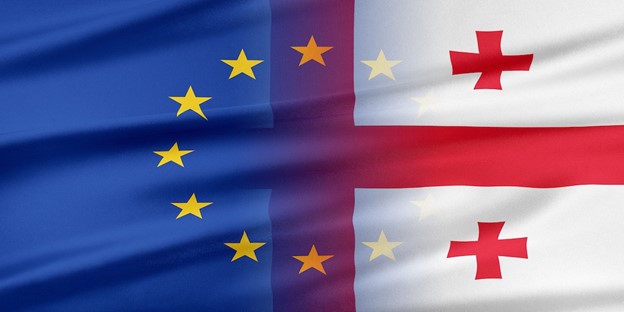
The EU and Georgia have long lasting and dynamically progressing cooperation over the years.
Today these relations became closer than ever, in light of Georgia’s application for the EU membership, submitted on 3 March 2022 and Georgia’s European perspective, received in response on 23 June 2022. Georgia was given a European perspective. and on 15 December 2023 Georgia was granted the EU Candidate Status.
This privilege brings in Georgia’s agenda higher commitments and aspirations for alignment and integration with the EU. Following this possibility and commitments the Georgian National Agency for Standards and Metrology (GeoSTM) started process of acquiring membership in the European regional metrology organization EURAMET (the European Association of National Metrology Institutes). On November 2022 GeoSTM became an associate member of EURAMET. EURAMET membership is enabling GeoSTM to cooperate amongst the leading national metrology institutes of Europe. GeoSTM aims to achieve higher integration through becoming full member of EURAMET.
4. Internationally recognized Metrological Infrastructure in GEORGIA
The Quality Management System according to the International Standard ISO/IEC 17025 has been implemented in the Metrology Institute of GeoSTM in order to achieve international recognition.
The recognition allows Georgian enterprises, laboratories, and other interested parties to obtain measurement services within Georgia, which will significantly decrease costs for calibration, transportation, customs, etc.
With significant and continued support from EU GeoSTM achieved international recognition of the Quality Management System in accordance with the Standard ISO/IEC 17025 through peer reviews conducted by COOMET, the Euro-Asian Cooperation of National Metrological Institutions in the field of electrical measurements, mass and temperature. The mentioned assessment was performed by the experienced technical experts from members of COOMET and by the experts from Germany and Lithuania. The next cycle of the peer review QMS of was held in GeoSTM on October 2018 within COOMET. The Metrology Institute of GeoSTM achieved and maintains international recognition in the following fields : electrical measurements, temperature, humidity, mass, small volume, pressure, length and ionizing radiation.
In July 2023 an on-site peer visit was carried out in GeoSTM by an EURAMET team composed of experienced technical experts from INRiM (Italy) and CEM (Spain) in the following measurement fields: mass, small volume, electrical measurement, temperature and humidity. The Quality Management System (QMS) was also covered. During the audits almost all the CMCs published in the BIPM KCDB (60 entries out of 65 CMCs) for the relevant quantities were checked. The QMS is intended to support the development and improvement processes of GeoSTM and provide a tool for a better international recognition, establishing and enhancing confidence in their fulfillment of the requirements of CIPM MRA. The general opinion of the team members was that GeoSTM has an adequate QMS and its implementation demonstrates conformity with the requirements of the CIPM MRA. All these laboratories successfully passed the peer-assessment by EURAMET. Having become an associate member of EURAMET it became relevant for more integration of GeoSTM into EURAMET to transfer and publish CMC entries within EURAMET.
According to the positive results of the assessment, the metrological infrastructure technical competence of the country was recognized, that promoted the increase of the potential exports of the country and facilitates access of Georgian products on international markets.
GeoSTM is a regional metrological service provider in the South Caucasus and different interested parties from Armenia, Azerbaijan, Turkmenistan received metrological services in GeoSTM.
4.1. GeoSTM National Metrology Institute’s Achievements in Calibration and Measurement Capabilities.STM y sus logros
The Metrology Institute of Georgia is a structural unit of GEOSTM. The Metrology Institute is composed of the following reference divisions:
- Electricity Reference Division
- Mass and Related Quantities Reference Division
- Temperature and Humidity Reference Division
- Dimensional Measurement Reference Division
- Radiophysics, Optics and Acoustics Reference Division
- Radiation Metrology Reference Division
- Mechanics Reference Division
- Physical Chemistry Reference Division
- Measuring Instruments Registry and Legalization Service
5. Brief information of activities done in the different divisions and laboratories
5.1. Electrical Measurement Reference Division
Since 2013, the Electricity Reference Division has been internationally recognized according to ISO/IEC 17025, within the framework of COOMET until 2018 and within the framework of EURAMET since 2023.
There are 19 CMCs published in the BIPM database (https://www.bipm.org/kcdb/)
| The department maintains and serves maintains 6 state (national) standards: | The main service of the department is the calibration of measuring instruments: | |
|---|---|---|
| 1. State (National) Standard of DC Voltage Range CC V= 10 mV – 1000 V 2. State (National) Standard of DC Resistance Range CCR= 0,001 ohm – 100 Tohm 3. State (National) Standard of Reference Capacitance and Dissipation factor Range: AC C=10 pF – 100 µF; Primary voltage 100 V – 70 kV; Frequency: 50 Hz 4. State (National) Standard of AC Current Ratio and Phase Displacement Range: Primary current 1 A – 2000 A, Frequency: 50 Hz; 5. State (National) Standard of AC Voltage Ratio and Phase Displacement Range: Primary voltage 500 V – 75kV; Secondary voltage100 V and 100/√3 V; Frequency: 50 Hz; 6. State (National) Standard of AC power and energy Range: 1-phase (0 – 60000)W; 3-phase (0 – 180000)W; Frequency: 45 – 65 Hz | DC and AC voltage and current calibration: • DC voltage standards • DC and AC voltage measuring instruments • Multimeters • Calibrators • Dividers • Amplifiers • Standard cells and etc. Calibration of electrical circuits parameters: • Reference Resistors • DC Resistance Standards • Ohmmeters, • Multimeters • Impedance calibrators • Impedance dividers • Capacitors • Resistance and capacitance boxes • Bridges and others Calibration of voltage and current scaled conversion measuring instruments: • Single and three-phase high voltage transformers • Current transformers • Current Clamps • Kilovoltmeters • AC voltage and current divider • High voltage and current measuring instruments Calibration of 1-phase and 3-phase power and energy measuring instruments : • Electricity meters • Power and energy measuring instruments • Power converters • Wattmeters | 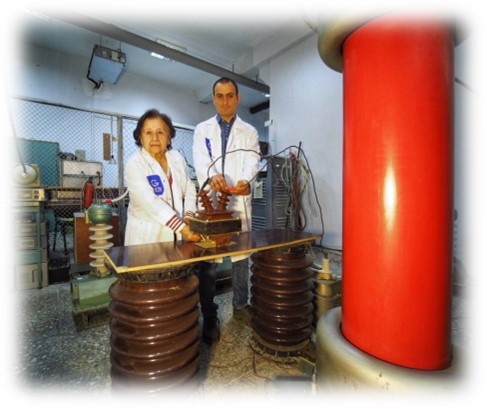 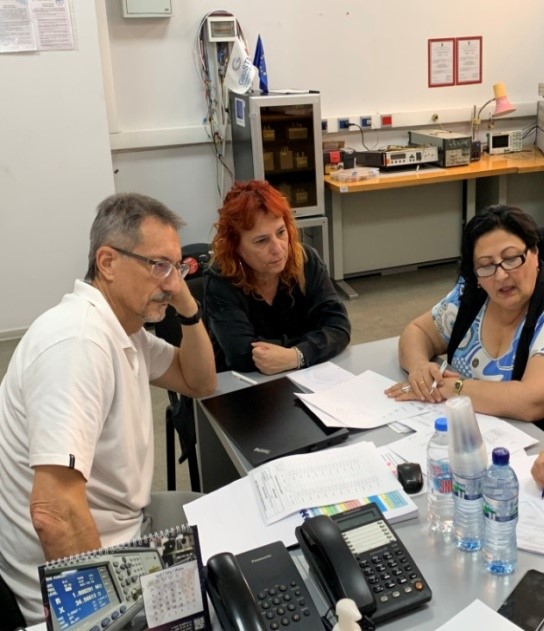 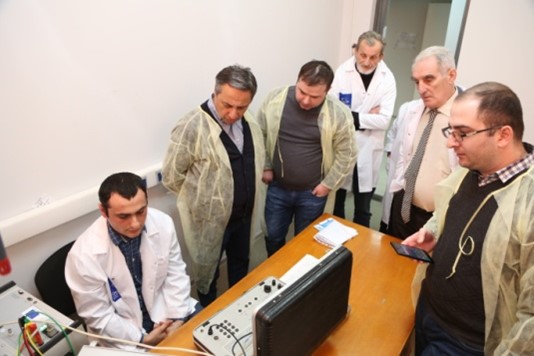 |
Other activities performed by the division:
- Participation in international comparisons as a pilot (within COOMET):
- COMET.EM-S17: supplementary comparison on 10 Ω and 100 kΩ resistance standards, coordinated by Manana Gelovani (GeoSTM, pilot) and Bernd Schumacher (PTB).
- COMET.EM-S19: supplementary comparison on 100 Ω and 100 kΩ Resistance standards. 11 national metrology institutes took part in the comparison: GeoSTM, pilot (Georgia); VNIIM (Russian); BELGIUM (Belarus); AzMi (Azerbaijan); IMBIH (Bosnia and Herzegovina); INIMET (Cuba); KazInMetr (Kazakhstan); VMT/FTMC (Lithuania); INM (Republic of Moldova); MASM (Mongolia), NSC”Institute of Metrology” (Ukraine). The traveling standards for this comparison were kindly supplied by the Physikalisch Technische Bundesanstalt (PTB, Germany).
- Participation in CMC review: The Head of the Division was invited as a reviewer within COOMET to carry out international assessment of CMCs of other national metrology institutes within the Regional Metrology Organisations (RMOs) of APMP, AFRIMETS and of others.
- Participation in Peer reviews: The Head of the Division was invited as a technical expert within COOMET to conduct peer reviews of other national metrology institutions such as Azerbaijan (AzMi), Cuba (INIMET), Uzbekistan (UzNIM), Ukraine (Ukrmeterteststandard and NSC -Institute of Metrology;), Russia (VNIIM and its branch FGUP “UNIIM”) and metrology institutes of Belarus (BELGIM).
- Participation in the trainings organized by BIPM: the Head of Division was invited as a lecturer to conduct a training with title “How to effectively participate in international comparisons” in which 25 students were invited from Asia, Africa, America and 20 countries of the former USSR and 5 from the metrological organization COOMET, AFRIMET, SIM, GULFMET, APMP.
5.2. Mass and Mass Related Quantities Reference division
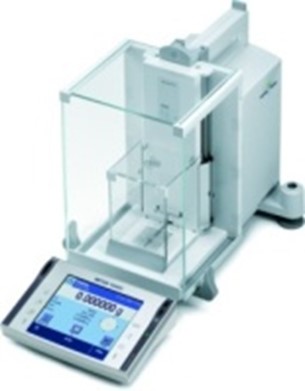
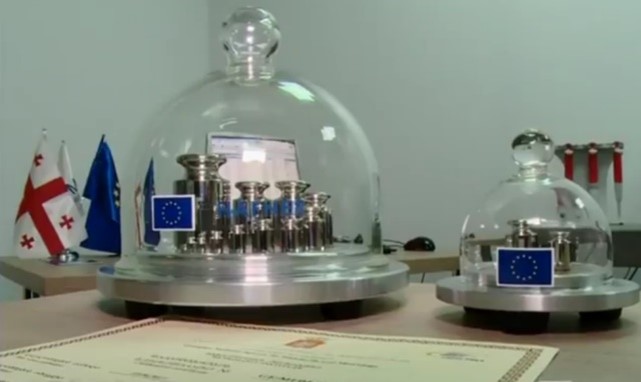
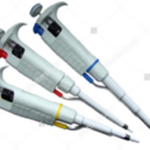
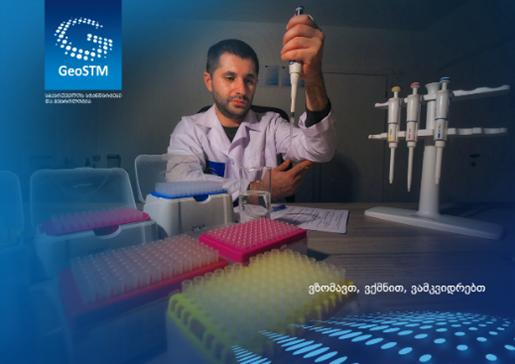
The following scheme presents the current capabilities of the Mass and Mass Related Quantities Reference Division:
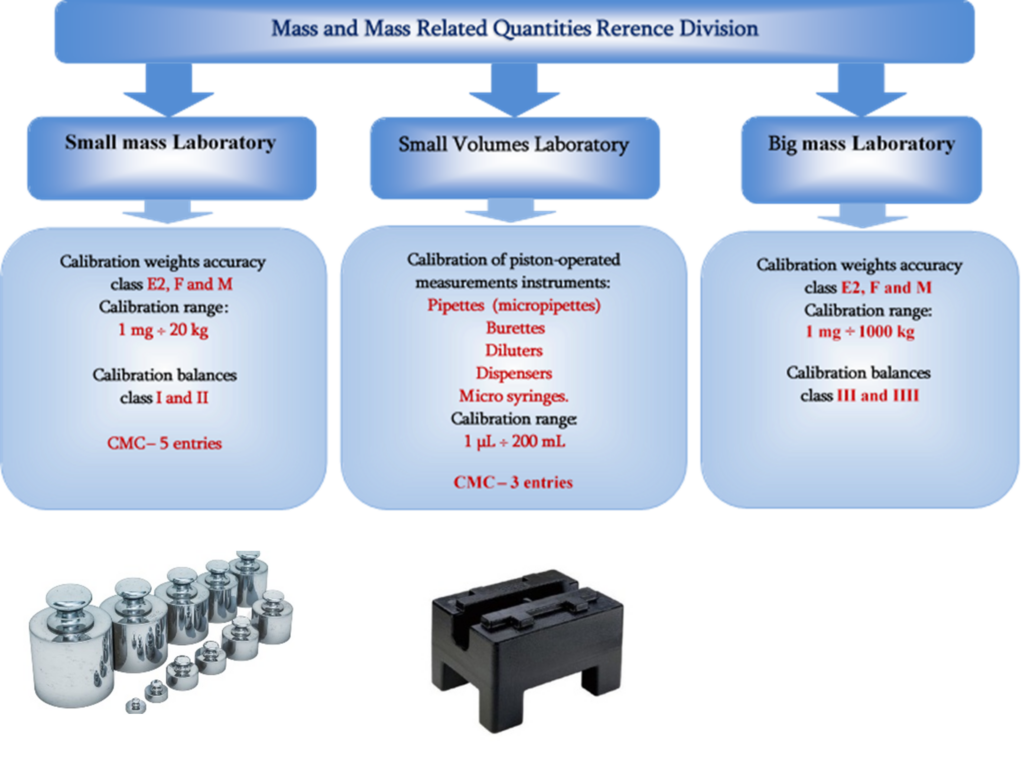
Other activities performed by the division:
- Participation in Peer review: The Head of the Laboratory was invited as a technical expert of COOMET to conduct peer reviews of other national metrology institutions: Moldova (INSM), Azerbaijan (AzMi), Ukraine (Ukrmeterteststandard and NSC – Institute of Metrology) and Turkmenistan (Turkmenstandartlary).
- Participation in CMC review: The Head of the Laboratory was invited as a reviewer within COOMET to carry out international assessment of CMCs of other national metrology institutes such as Azerbaijan (AzMi), AFRIMETS, SIM (Costa Rica) and other RMOs.
- Participation in international comparisons as a pilot (within COOMET):
- COOMET.M.M-S1 (also known as supplementary comparison COOMET 581/GE/12). The comparison measurements between the two participants GeoSTM (and PTB were started in August 2012 and finished in June 2013.
- Participation in Volume comparison at 10 μL, 100 μL and 1000 μL—calibration of micropipettes. Volume comparison at 10 mL—calibration of burette. International comparison within COOMET.M.FF-S8 (also known as supplementary comparison COOMET.M no. 767/GE/18). The comparison measurements between the two participants GeoSTM (pilot ) and IPQ —Portugal started in August 2018 and finished in December 2018.
5.3. Temperature and Humidity Reference division
The following pictures summarizes the current capabilities of this division:
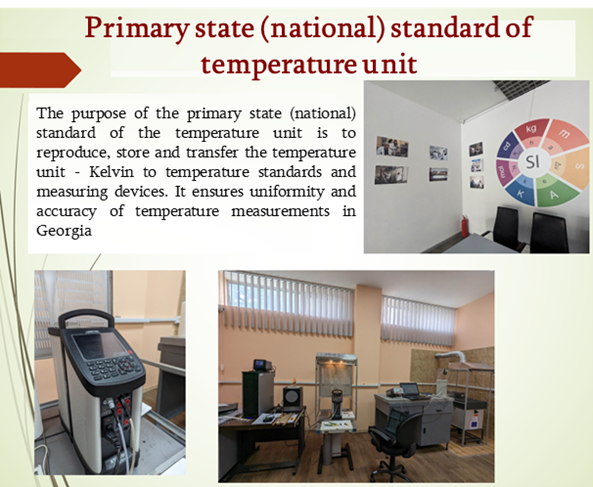
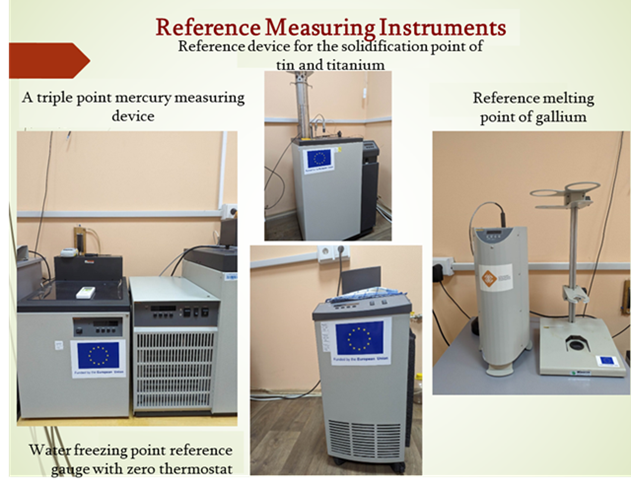
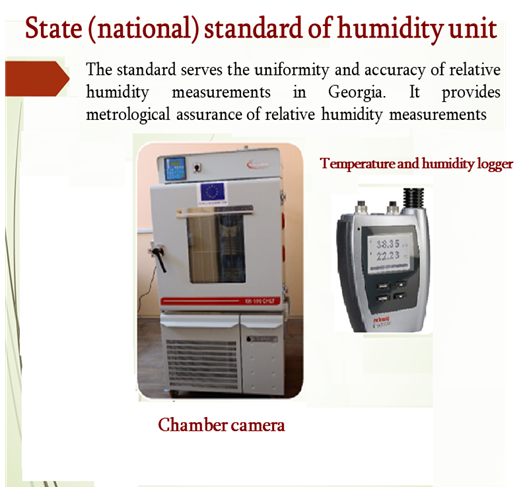
Other activities performed by the division:
- Participation in international comparisons as a pilot (within COOMET):
- COOMET.T-K3.2 (COOMET theme No. 494/RU/10): Realizations of the ITS-90 from 0.01 C to 419.572 C (2010–2012). COOMET regional key comparison corresponding to CCT-K3 and covering the temperature range from 273.16 K (triple point of water) to 692.77 K (freezing point of Zn). Three National Metrology Institutes, VNIIM (Russian Federation), INSM (the Republic of Moldova) and GeoSTM (Georgia) participated in this regional COOMET comparison.
- Supplementary comparison COOMET.T-S3 (also known as supplementary comparison COOMET 768/GE/18) on relative humidity (RH) from 30 % rh to 90 % rh at 23 °C. The comparison was organized between the National Physical Laboratory (NPL) United Kingdom (Laboratory-coordinator) and Georgian National Agency for Standards and Metrology (GeoSTM), Georgia. The comparison started in July 2018 and finished in September 2019.
- Within the framework of the regional project PTB No. 95333-02 “Strengthening of quality infrastructure in the South Caucasus” 2019-2022 within A comparison was made on the topic: “Calibration of digital thermometer by direct comparison method in a thermostat in the range up to (-30 ÷ 300) °C” . Three countries of South Caucasus: Georgia, Azerbaijan and Armenia participated in the comparison. The pilot laboratory was GeoSTM’s temperature measurement laboratory. The coordinator of the comparison was the Head of the Temperature and Humidity Reference Division.
5.4. Pressure Reference Laboratory
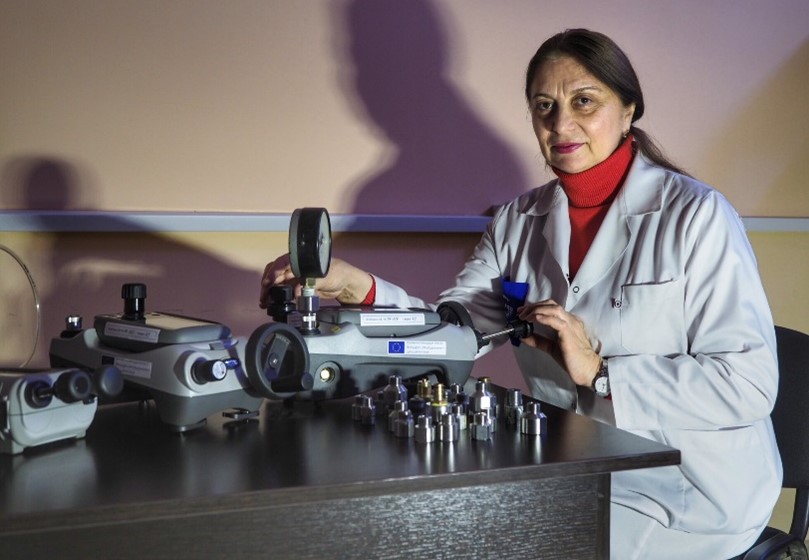
Manometers of different ranges are calibrated in the laboratory of pressure measurements with the help of pressure calibration devices purchased within the framework of an EU project.
The main activities of the laboratory areas follows:
- Maintaining/developing national standards
- Conducting calibration activities in accordance with ISO/IEC 17025 requirements (ensuring uniformity of pressure measurement)
- Consultations and exchange of experience with other National Metrology Institutes.
- The laboratory serves both public institutions and the private sector (accredited laboratories, etc.)
- Participation in international comparisons:
- Two-phase interlaboratory comparison between the Georgian National Agency for Standards and Metrology (GeoSTM), Czech Metrology Institute (CMI) and Slovak Metrology Institute (SMU) denoted as COOMET.M.P-S4. The ranges of the absolute pressure from 0 MPa to 7 MPa and gauge pressure from 0 MPa to 2 MPa were chosen as the most suitable for a mutual comparison. A digital pressure gauge, DHI RPM4 served as a transfer standard in both phases. Firstly, bilateral interlaboratory comparison (BILC) between two participants, CMI (pilot and reference laboratory) and GeoSTM, started in March 2017 and finished in April 2017. Secondly, interlaboratory comparison (ILC) between three participants, CMI (pilot and reference laboratory), SMU (co-reference laboratory) and GeoSTM, started in October 2018 and finished in February 2019. SMU took part only in the absolute pressure comparison.
5.5. Dimensional Measurements Reference Division
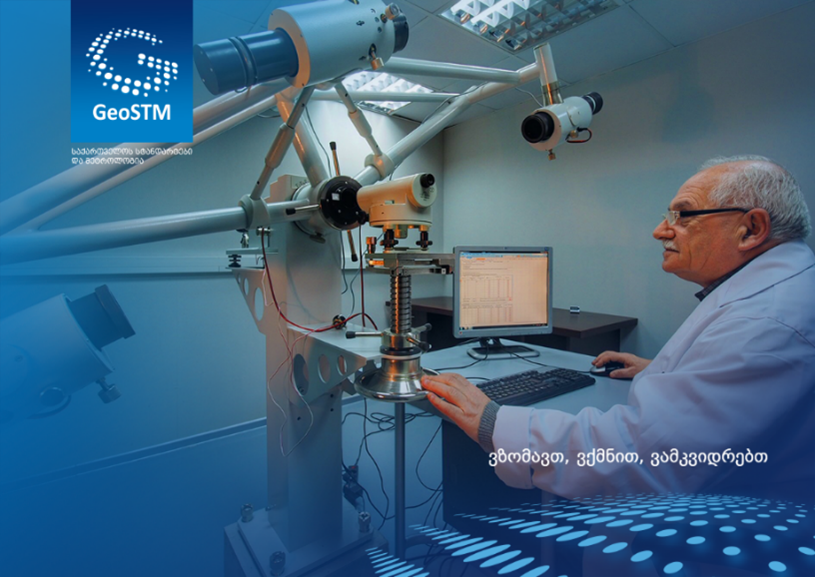
The main activities of the Dimensional Measurement Reference Division include the development and improvement of the state (national) standards of length and angle as well as the calibration/verification of measuring instruments existed in the mentioned fields whereby the major problem of contemporary metrology – the unification of measurements – is solved.
In addition to the provision of interested organizations with consulting services in a relevant field and sharing the knowledge and experience gained at foreign Metrology Institutes with other calibration laboratories as well as specialists of the industrial field.
The Dimensional Measurement Reference Division delivers its services both to the state authorities and private business sector.
The division takes participation in international comparison:
- СООМЕТ No. 765/UA/18: bilateral comparison of length standards for measuring end measures with Kharkov Institute of Metrology in the range up from 0.5 mm to 100 mm, to measure the end measures of length from steel (gauge blocks) with a nominal size of 1.28 mm; 70 mm; 100 mm by the mechanical method in 2018
The Head of the Division, Vazha Sikharulidze was invited as a technical expert to conduct a peer-review in the Scientific-research laboratory “Length and Dimensions” of Kharkov Institute of Metrology in Quality Management System Inspection/Assessment.
5.6. Radiation Metrology Reference laboratory
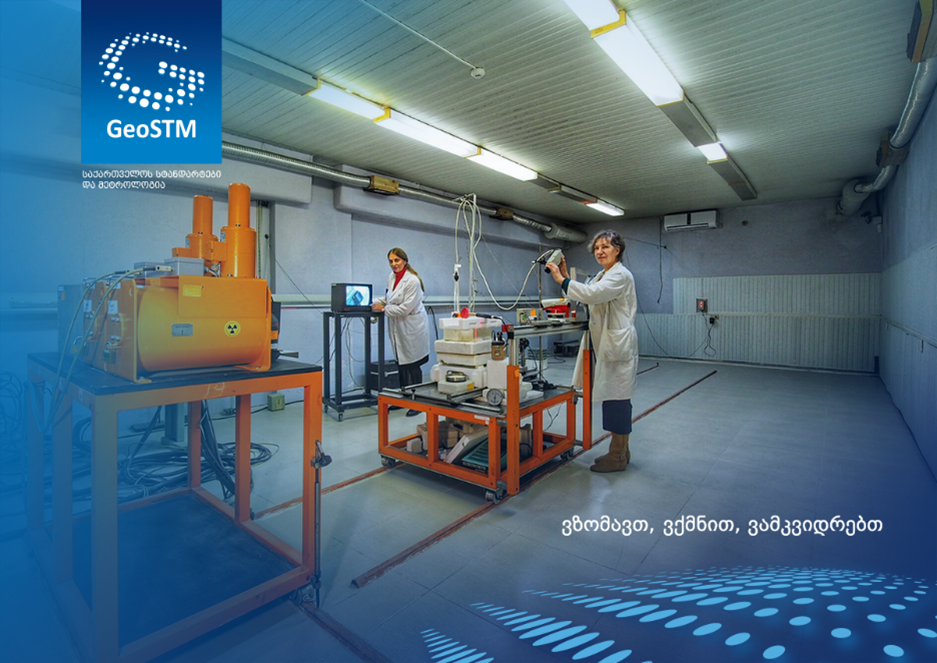
The Secondary Standards Dosimetry Laboratory (SSDL) was established in 2003 with the support of the International Atomic Energy Agency (IAEA).
Since 2004, the laboratory is a member of the World Health Organization Agency (IAEA/WHO NETWORK, see SSDL Newsletter No. 50-2005) and is under the supervision of the International Atomic Energy Agency. SSDL is a laboratory that provides the necessary connection for consumer radiation metrology with the International System of Measurement of Radiation Dosimetry (SI). The laboratory takes participation in international comparison within COOMET:
- COOMET supplementary comparison of the national measurement standards for air kerma in 137Cs γ radiation at protection level (~10 mGy/h). Ten National Metrology Institutes from the COOMET organization and the International Atomic Energy Agency participated in this COOMET project no. 445 – in 2011-2013 (PTB -Germany, BelGIM- Belarus , GeoSTM -Georgia ,INSM- Moldova, CPHR-Cuba, NSC-“IM”- Ukraine; SMU- Slovakia ; VNIIM- Russia ; BIM,-Bulgaria; VMT/FTMC,-Lithuania ; IAEA,-Vienna).
6. A new measurement field to be implemented
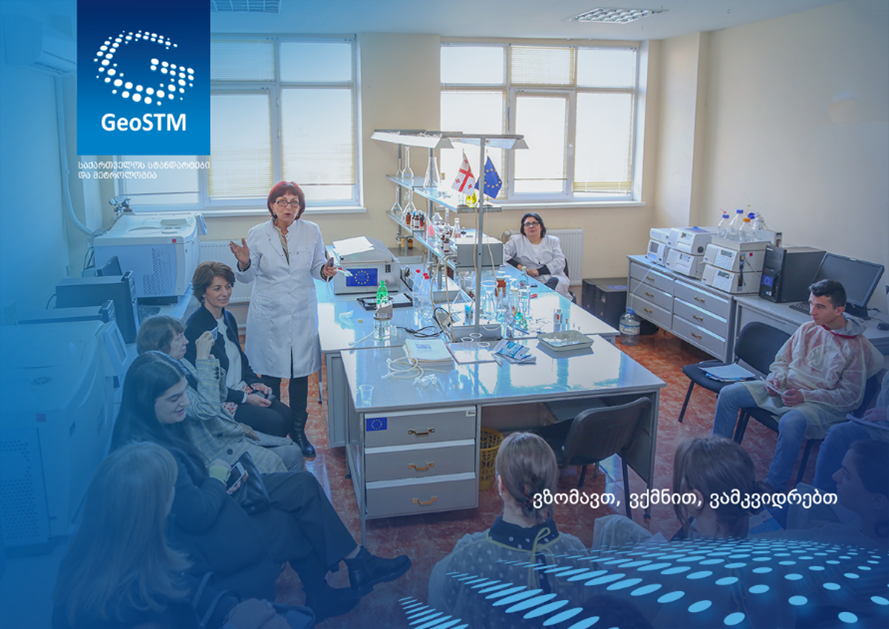
Following the tendency of steady increase of Georgian export to EU there is an increasing need to ensure availability of priority services as well as to ensure international recognition in more and more fields of measurements. Particularly there is high demand in reference materials and certified reference materials from different sectors e.g. testing laboratories, food producers and processing companies, pharmaceutical companies, wine sector etc.
Enterprises especially, export oriented ones will be provided with these services locally, instead of sending their measurement instruments abroad, while internationally recognized service is already available in Georgia. They will benefit in terms of saving their costs (the cost of calibration, transportation, customs and other expenses), that in its turn, will support improvement of product competitiveness.
Conclusion
GeoSTM is responsible for making available standards, particularly harmonized European standards, on the one hand and ensuring needed traceability of measurementsand availability of internationally recognized services in priority fields of measurements, on the other hand. GeoSTM has been participating in activities within the relevant international/regional organizations e.g. ISO, IEC, BIPM, OIML, CEN, CENELEC, EURAMET which are platform to discuss and follow the policies, rules and procedures based on established practice and update according to international practices, as well as EU regulations.


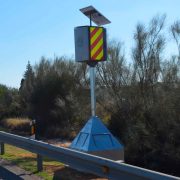
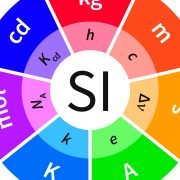
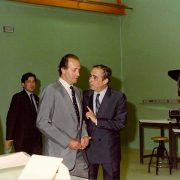

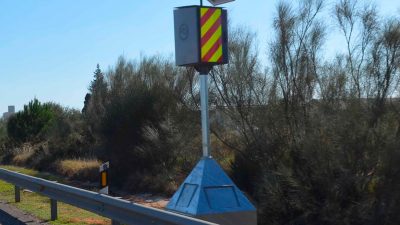
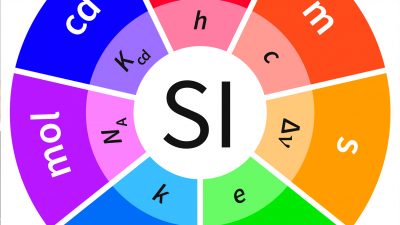
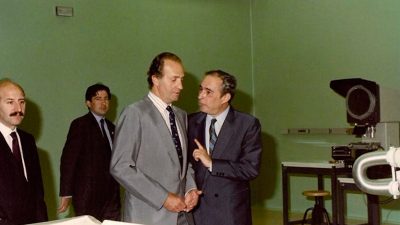
Comentarios